Assembly of the Caulobacter cell division machine
- PMID: 21542856
- PMCID: PMC3707389
- DOI: 10.1111/j.1365-2958.2011.07677.x
Assembly of the Caulobacter cell division machine
Abstract
Cytokinesis in Gram-negative bacteria is mediated by a multiprotein machine (the divisome) that invaginates and remodels the inner membrane, peptidoglycan and outer membrane. Understanding the order of divisome assembly would inform models of the interactions among its components and their respective functions. We leveraged the ability to isolate synchronous populations of Caulobacter crescentus cells to investigate assembly of the divisome and place the arrival of each component into functional context. Additionally, we investigated the genetic dependence of localization among divisome proteins and the cell cycle regulation of their transcript and protein levels to gain insight into the control mechanisms underlying their assembly. Our results revealed a picture of divisome assembly with unprecedented temporal resolution. Specifically, we observed (i) initial establishment of the division site, (ii) recruitment of early FtsZ-binding proteins, (iii) arrival of proteins involved in peptidoglycan remodelling, (iv) arrival of FtsA, (v) assembly of core divisome components, (vi) initiation of envelope invagination, (vii) recruitment of polar markers and cytoplasmic compartmentalization and (viii) cell separation. Our analysis revealed differences in divisome assembly among Caulobacter and other bacteria that establish a framework for identifying aspects of bacterial cytokinesis that are widely conserved from those that are more variable.
© 2011 Blackwell Publishing Ltd.
Figures

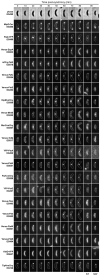



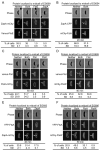
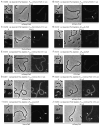
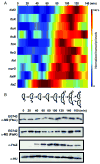
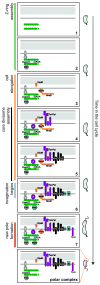
Similar articles
-
FtsA Regulates Z-Ring Morphology and Cell Wall Metabolism in an FtsZ C-Terminal Linker-Dependent Manner in Caulobacter crescentus.J Bacteriol. 2020 Mar 11;202(7):e00693-19. doi: 10.1128/JB.00693-19. Print 2020 Mar 11. J Bacteriol. 2020. PMID: 31932314 Free PMC article.
-
DipM, a new factor required for peptidoglycan remodelling during cell division in Caulobacter crescentus.Mol Microbiol. 2010 Jul 1;77(1):90-107. doi: 10.1111/j.1365-2958.2010.07224.x. Epub 2010 May 24. Mol Microbiol. 2010. PMID: 20497502 Free PMC article.
-
The Chaperonin GroESL Facilitates Caulobacter crescentus Cell Division by Supporting the Functions of the Z-Ring Regulators FtsA and FzlA.mBio. 2021 May 4;12(3):e03564-20. doi: 10.1128/mBio.03564-20. mBio. 2021. PMID: 33947758 Free PMC article.
-
A new factor stimulating peptidoglycan hydrolysis to separate daughter cells in Caulobacter crescentus.Mol Microbiol. 2010 Jul 1;77(1):11-4. doi: 10.1111/j.1365-2958.2010.07225.x. Epub 2010 May 24. Mol Microbiol. 2010. PMID: 20497501 Review.
-
Morphogenesis of rod-shaped sacculi.FEMS Microbiol Rev. 2008 Mar;32(2):321-44. doi: 10.1111/j.1574-6976.2007.00090.x. FEMS Microbiol Rev. 2008. PMID: 18291013 Review.
Cited by
-
Three-dimensional super-resolution imaging of the midplane protein FtsZ in live Caulobacter crescentus cells using astigmatism.Chemphyschem. 2012 Mar;13(4):1007-12. doi: 10.1002/cphc.201100686. Epub 2012 Jan 20. Chemphyschem. 2012. PMID: 22262316 Free PMC article.
-
A NAD-dependent glutamate dehydrogenase coordinates metabolism with cell division in Caulobacter crescentus.EMBO J. 2015 Jul 2;34(13):1786-800. doi: 10.15252/embj.201490730. Epub 2015 May 7. EMBO J. 2015. PMID: 25953831 Free PMC article.
-
Bacterial protein networks: properties and functions.Nat Rev Microbiol. 2015 Sep;13(9):559-72. doi: 10.1038/nrmicro3508. Epub 2015 Aug 10. Nat Rev Microbiol. 2015. PMID: 26256789 Review.
-
Agrobacterium tumefaciens divisome proteins regulate the transition from polar growth to cell division.Mol Microbiol. 2019 Apr;111(4):1074-1092. doi: 10.1111/mmi.14212. Epub 2019 Mar 4. Mol Microbiol. 2019. PMID: 30693575 Free PMC article.
-
DCAP: a broad-spectrum antibiotic that targets the cytoplasmic membrane of bacteria.J Am Chem Soc. 2012 Jul 18;134(28):11322-5. doi: 10.1021/ja302542j. Epub 2012 Jul 5. J Am Chem Soc. 2012. PMID: 22741745 Free PMC article.
References
-
- Aaron M, Charbon G, Lam H, Schwarz H, Vollmer W, Jacobs-Wagner C. The tubulin homologue FtsZ contributes to cell elongation by guiding cell wall precursor synthesis in Caulobacter crescentus. Mol Microbiol. 2007;64:938–952. - PubMed
-
- Aarsman ME, Piette A, Fraipont C, Vinkenvleugel TM, Nguyen-Disteche M, den Blaauwen T. Maturation of the Escherichia coli divisome occurs in two steps. Mol Microbiol. 2005;55:1631–1645. - PubMed
-
- Addinall SG, Cao C, Lutkenhaus J. FtsN, a late recruit to the septum in Escherichia coli. Mol Microbiol. 1997;25:303–309. - PubMed
Publication types
MeSH terms
Substances
Grants and funding
LinkOut - more resources
Full Text Sources

